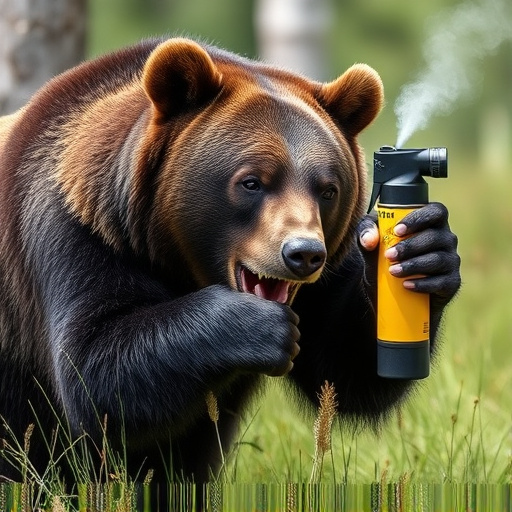Understanding bear behavior is key for anyone in bear habitats. Bear spray, with an 80-95% success rate when sprayed directly into a bear's face, is a powerful tool but requires correct application and doesn't guarantee safety alone. Additional measures like noise-making, appearing larger, carrying self-defense tools, and understanding bear behavior are crucial for enhancing safety in bear country. Recognizing context triggers for attacks helps avoid dangerous situations.
In the vast wilderness, encountering a bear can be a thrilling yet potentially dangerous experience. Understanding bear behavior is key to survival. This article equips readers with essential knowledge about bear attack patterns and effective protection methods. We delve into the power of bear spray, examining success rate statistics to determine its efficacy as a defensive tool. Additionally, discover other survival strategies that go beyond spray, enhancing your chances in the face of these formidable predators.
- Understanding Bear Behavior and Their Attack Patterns
- Bear Spray: A Closer Look at Its Success Rate and Efficacy
- Additional Survival Strategies Beyond Bear Spray
Understanding Bear Behavior and Their Attack Patterns
Understanding bear behavior is crucial for anyone venturing into wilderness areas known for bear populations. Black bears and grizzly bears (brown bears) have distinct attack patterns influenced by their natural instincts and human interactions. Knowledge of these behaviors can significantly enhance your safety during encounters. Research shows that bear spray, when used correctly, has a success rate of around 80-95% in deterring attacking bears.
While no single action guarantees protection, carrying and knowing how to use bear spray is a key strategy. Additionally, making loud noises, waving your arms, and maintaining a visible presence can often deter a bear from approaching. Understanding the context that triggers an attack—such as surprising a bear cub or encroaching on its food source—is essential for avoiding potentially dangerous situations.
Bear Spray: A Closer Look at Its Success Rate and Efficacy
Bear spray has emerged as a popular defense mechanism for outdoor enthusiasts navigating wilderness areas known to harbor bears. When used correctly, it’s considered an effective deterrent against bear attacks. Studies have shown that bear spray can significantly reduce the risk of injury during encounters with defensive or curious bears. According to research, bear spray has a success rate of around 80-95% in deterring bears when sprayed directly in their faces. This high efficacy is attributed to the capsaicin and other chemicals in the aerosol, which temporarily blind and irritate the bear’s eyes and respiratory system.
However, it’s crucial to remember that bear spray isn’t a guarantee of safety. Its effectiveness depends on factors like the user’s proximity to the bear, weather conditions (wind direction and speed), and the bear’s behavior and size. Therefore, while bear spray is a valuable tool for wilderness survival, users must also rely on other precautions such as making noise while hiking, storing food securely, and knowing how to react during an encounter.
Additional Survival Strategies Beyond Bear Spray
In addition to bear spray, which boasts a success rate of around 80% in preventing attacks, there are several other survival strategies to consider when venturing into wilderness areas known for bear populations. Understanding and practicing these techniques can significantly enhance your chances of avoiding and escaping a potential encounter. One key strategy is noise management; making loud noises while traveling through bear country can deter bears from approaching, as they often associate quiet with stealthy predators.
Another effective method is to make yourself appear larger. Raising your arms or wearing brightly colored clothing can help bears recognize you as a human and not a potential prey item. Additionally, carrying and knowing how to use a knife or other self-defense tool can provide an extra layer of protection in case of an attack. Familiarizing yourself with bear behavior and being aware of their scent trails can also aid in early detection, allowing for a safe retreat before a confrontation becomes necessary.
While bear spray has proven effective in many situations, with success rate statistics showing a significant reduction in attacks, it’s crucial to remember that no single method guarantees complete protection. Understanding bear behavior and employing additional survival strategies are essential components of wilderness safety. Combining knowledge, preparation, and a blend of tools like bear spray with other tactics ensures a greater chance of navigating potential encounters safely. Remember, awareness, prevention, and knowing when to apply different techniques can make all the difference in a wild environment.
